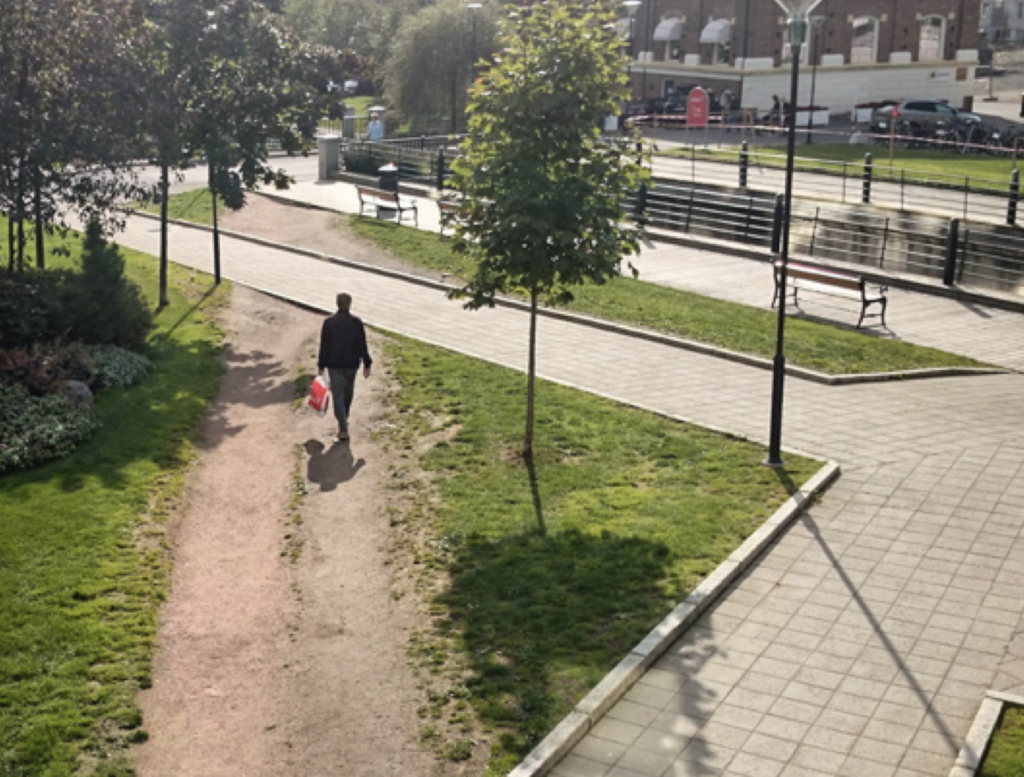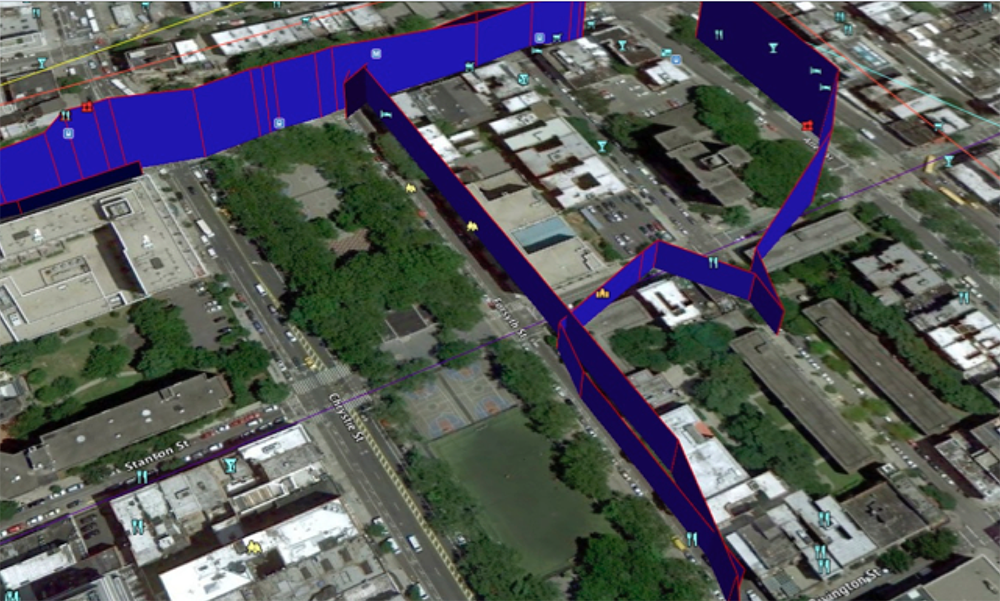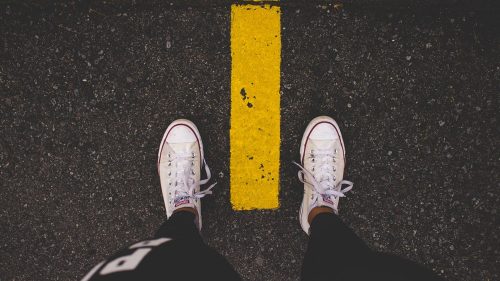What does it mean to ask whether a city is conscious? On first reflection, the question seems preposterous. How can sidewalks, bricks, walls and glass have anything like awareness, even when pulsing with the electrical, pneumatic and hydraulic vitality of a city’s systems? We can suppose that the real city is not composed of the matter that is used to build it any more than my own real consciousness has much to do with the slab of water, fat and bio-chemicals that sits atop my shoulders. Supposing then that I imagine that, whatever consciousness might be, it has more to do with a dynamic network of activity, an immaterial web of information and interaction. Can a city have that? Of course it can! But what more is required before I would want to entertain the possibility that a city could be conscious? A too liberal definition of that word might mean that when I go home after work tonight, I’ll worry that the thermostat controlling my furnace is the winking eye of a sentient system that has been waiting in mute anticipation for my return. I’m not sure that I want that kind of relationship with my thermostat. Scientifically-inclined philosophers and philosophically-inclined scientists have sometimes made the arm-waving argument that when an information processing network becomes big, bad, and bold enough, it might make sense to say that it is conscious. So perhaps somewhere between the thermostat and a massive Deep Blue level of computing power that can exceed certain human capabilities and generate a convincing simulacrum of sentience, we might be tempted to believe that we’ve accomplished an intelligent and perhaps even an aware city—a conscious city. Our blind confidence in the inexorable march of technology makes such a future possibility seem like inevitability.
But what I’d like to suggest is that when we think of this kind of techno-utopian future city, studded with sensors and actuators, sorting massively complex systems in such a way as to achieve efficiencies of everything from transportation and parking spots to lineups for seating at the hot local restaurant, we may have hurtled past the simple essence of city consciousness. Perhaps we just need to think about consciousness and cities in a different way.
A few years ago, the physical infrastructure on my street was upgraded, which required that the sidewalk be torn up. On the day that the new paving was poured in front of our house, my wife and I sneaked out after dark and, like errant children, we carved our names into the still-wet paving. It wasn’t a deeply considered act, nor was it in any way unique. For as long as there have been affordances for marking up our environment, there have been such declarations of attachment. But our sweet act of sentimentality has had an enduring, resonant effect on us. When I leave my house on foot, I see the carved initials and I remember the day that we put them there. Those concrete etchings triangulate through space and time, embedding me, my wife, and our home in a rich skein of place. Although the broader associations and memories of that episode might be entirely private, shared only between the two of us, it’s hard not to imagine that the sidewalk in front of our house participates in the network. Of course it would be absurd to suppose that the concrete itself is aware of us, or the love that we share. But the pattern we made in the concrete is the medium that, along with the neural activity in both of our brains and the events of the day itself, constitutes the experience. In the sense in which cognition and affect are enactive and embodied and not representational and constrained by the margins of the cranium of the actor, this little bit of the city in front of my house constitutes a bona fide element of a shared human experience.

Manifestations of human experience in the bricks and mortar of a city can transcend intimate declarations of emotion shared by lovers. Sometimes they are communal. I live in Canada, a Northern country that is blanketed by snow for a part of each year. After each new snowstorm, the visible lines of human desire appear quickly as tracks of footprints dot the city. Often, these tracks conform to the lines laid out carefully by city planners, but sometimes not. The footprints can be physical marks of consent or of conflict. In the latter case, these kinds of indexical marks represents an argument—an insistent vote with human feet that somebody got something wrong. In other cases the desired lines might represent something more like an alternative interpretation of the meaning of a streetscape. Its designers may have envisioned one particular set of uses but the citizens who use the design see and feel something else, and they act out these perceptions and feelings with their bodies, leaving an ephemeral physical trace like the frozen residue of a flash-mob. In many cases, the marks of human use of a setting build up over much longer periods of time. Patterns of wear on lawns, walkways, stairwells, railings and walls trumpet meaning. Unlike my scratched initials in front of my house, though, these data come from an anonymous collective, usually building slowly over years, decades or perhaps even centuries. Nevertheless, it’s worth asking the question: in the same way that my bit of love graffiti participated in a network of meaning and feeling, where actor and object were inseparably connected, can one consider such indexicals as these to constitute another way in which a city can capture and communicate thoughts, meanings, and memories? Are they another part of the fabric of a conscious city?
My third example comes from an experience during a recent visit to my childhood stomping grounds near London where I spent the first few years of my life. Not having returned to the area for about 40 years, I was keen to visit some of the sites that I knew would have had some meaning for me when I lived there—my home, my school, the parks where I’d played, the shopping areas that I had visited with my mother in my earliest days. During one of my walks, I climbed a grassy slope leading up to a wrought iron fence surrounding a church. As I walked past the fence, I felt its pull. It animated my legs, drawing me towards it. My arm rose so that I could slap my palm playfully on each picket as I walked past the fence. Though I have no conscious recollection of this, I felt as though my actions came from a set of enacted memories of previous encounters with the fence. I had been here and done this before. When I visited a nearby market square that contained a fountain, I felt a similar pull to enter the water (With some regret now, I managed to resist the pull). In this case, though I didn’t remember visits to the fountain, I did recall the many times my mother told stories of how I would run from her and leap into the water unless she was fast enough to catch me. Though these experiences are more ephemeral and mysterious than my accounts of love graffiti and desire lines, I feel as though there is a connection. Like my carved initials in the sidewalk, my connection with the fence and the fountain is private. But unlike the earlier case, there are no identifiable physical marks at the setting. My connection with these places, though invisible to outsiders, is nevertheless just as compelling for me and, just as in the case of my sidewalk, I want to say that this connection belongs to the fence as much as it belongs to me. Though I can describe my experiences to you, this third-hand account of the encounter is not at all the same thing as the movements and sensations of my upturned palm sweeping along the fence. The memory that I’m trying to describe isn’t the recollection of the experience but the entire enactment of the activity—the movements, the sensations, and the environment. The fence is just as integral to that as is my working nervous system.
My reason for going through these autobiographical minutiae relates to my suspicion that just as some modern notions of consciousness have emphasized its intersubjectivity and the central role of empathy in a full understanding of human awareness 7, it might also make sense to consider the interconnectedness of human actor and city as the ground for understanding how a city might be said to have anything like consciousness. In the examples that I’ve cited, the awareness, attachment, and memory states belong neither to the human beings on the scene nor to the physical materials of the site, but to both. Indeed, one interpenetrates the other to such a degree that it barely makes sense to consider them separately. This way of thinking about settings is very much akin to the thinking of early environmental psychologists like Roger Barker (1963) and Harold Proshansky (1976), who argued that any kind of attempt to understand human behaviour in vacuous laboratory settings was doomed to failure.
In these examples, although the environment is a full participant in the interactive loop that connects subject with setting, it only responds passively. It may, in the sense that I’ve just described, “know” something about the subject and it may even sometimes communicate what it knows to others (for example, I usually take desire lines in the snow seriously—they’re normally pointing the way to some kind of optimal behaviour such as the shortest or easiest route). But now we live in a world where a city consists of much more than the physical materials used to construct floors, walls and roofs. A typical street is teeming with information 3, some of which comes from the built structures themselves but some of which comes directly from the citizen. With the advent of new generations of simple sensors, some worn on the person and some embedded in the environment, the possibilities for much more full-blooded relationships between person and city, and perhaps even true empathic loops, may be on the horizon.
In our research at the Urban Realities Laboratory, we take advantage of such sensors to inquire about the relationship between simple physical variables in a setting and the psychological state of the user. In our experiments, we lead participants on curated walks through urban neighborhoods while asking them questions about what they see and feel and measuring the state of their bodies using bracelets that measure skin-conductance, pulse, or brain-waves. In our previous studies2 we have shown, for example, that there is a consistent relationship between the level of complexity and permeability that is present in the skins of buildings and the state of the nervous system. Higher levels of complexity and permeability lead to states of heightened positive affect and physiological arousal. Low levels of complexity lead to negative affect and low arousal. But it isn’t just the appearance of hard physical variables that influences emotional and physiological state. For example, in one study in New York, we discovered that psychological responses can sometimes depend on one’s familiarity with a site. First-time visitors to a bleak-looking affordable housing complex responded negatively to its appearance, whereas those familiar with the setting were more inclined to see through the façade itself, presumably connecting with the stories of the neighborhood – its culture and history.
In our experiments, we measure the responses of research volunteers to locations on carefully pre-planned routes. For us, as psychologists interested in urbanism, these methods yield valuable information about the effect of the fabric of a city on psychological response. In our experiments, we conceive of the city itself as a complex of independent variables and the responses of the participants as a plexus of dependent variables. But now imagine that the same methods and measures, becoming increasingly available as they are incorporated into wearables, become something different. Rather than a set of measurands available to experimenters to explicate urban psychology, can we think of the data flows that can be picked up by these wearables as a part of a city’s expression itself? As we move through a city, our hearts, brains, adrenal and sweat glands leave desire lines like footprints in the snow or hearts carved in concrete. These new tools just make visible what has been in cities all along, but their new availability, both to the city itself and to its human users, makes a massive difference. Is it possible to think beyond the instrumental idea that these indexicals serve as mere founts of human-centred information that could be used to tweak a city’s systems and, instead, think of this collection of information as a blazing gesture of self-expression? Can we understand this flame of human experience made visible as a kind of madly speeded-up incarnation of Aldo Rossi’s (1984) vision of a city’s memories but written in the ether rather than in its stone monuments? As our understanding of what a city might be is transformed by the seamless convergence of human activity and physical structure, it might be worth spending at least as much time reflecting on what these facts turn a city into as in how these facts can improve efficiencies, economies, and lives.
In an effort to explore such convergences in a scaled-down model system, the Urban Realities Laboratory has entered into a partnership with the Living Architecture Systems Group (LASG) headed by architect Philip Beesley. For the past twenty years, Beesley’s group has been designing ambitious interactive sculptures (the Sentient Veil) that respond to ambient events including human activity. With the emergence of the strongly multidisciplinary LASG, there is now an explicit agenda to understand how human interactions and experience with a physical system that exhibits life-like properties might broaden our understanding of the intersubjectivity of consciousness and empathy. Is it possible, for example, to design structures that, in some deep sense that transcends simple homeostatic systems like thermostats, actually care for us? Our initial hypothesis is that the extent to which a human visitor to a part of the Sentient Veil will enter into an empathic loop with the structure will depend on the extent to which there is an authentic sense of shared ownership of the structure’s body. In other words, observers who come to recognize or mirror the impact of their own mental states in the physical state of the structure will become much more likely to recognize and understand the structure’s behaviour as if it were alive. If this is true, then a genuine intersubjectivity among observers might be accomplished via shared mental “ownership” of the structure’s state.

These initial studies, using a small system that can fit into a room are obviously modest, but we anticipate that the processes that we can study in this system should also generalize to larger systems, such as a neighborhood or city. Ultimately, our objective is to explore the extent to which interactive, biologically attuned environments can be designed in such a way as to promote a profound sense of shared awareness and presence among the occupants of a large-scale space —perhaps even a city-sized one—that is based on neuroscientific principles. For better or for worse, this might be seen as the ultimate theoretical limit of a smart-city movement and worth exploring for that reason alone. At a more applied, head-below-the-clouds level, though, mounting evidence suggests that social cohesion in a city can serve to buffer its citizenry from some of the psychological ravages of life in dense, urban settings 3.If this is true, then a smart city designed with such deep sharing capabilities may also help us to build more psychologically sustainable settlements.
References
- Barker, RG (1963). The stream of behavior as an empirical problem. In R. G. Barker (Ed), The stream of behavior: Explorations of its structure & content, East Norwalk, CT, US: Appleton-Century-Crofts, pp 1-22.
- Ellard, CG & Montgomery C (2013). Testing, testing: A psychological study on city spaces and how they affect our bodies and minds (Report). New York, Guggenheim Museum. Retrieved from: http://cdn.bmwguggenheimlab.org/TESTING_TESTING_BMW_GUGGENHEIM_LAB_2013_2.pdf
- Hill, D (2008). The street as platform [Blog post]. Retrieved from http://www.cityofsound.com/blog/2008/02/the-street-as-p.html
- Hill, T. D., & Maimon, D. (2013). Neighborhood context and mental health. In Handbook of the sociology of mental health (pp. 479-501). Springer Netherlands.
- Proshansky, H (1976). Environmental psychology and the real world. American Psychologist, 31(4), 303-310.
- Rossi, A. (1984). The Architecture of the City. Cambridge, Mass: MIT Press.
- Thompson, E. (2001). Empathy and consciousness. Journal of Consciousness Studies, 8, 1-32.

